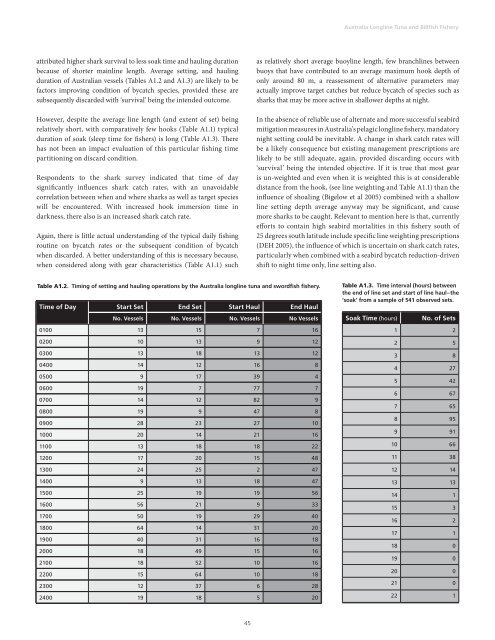Shark Depredation and Unwanted Bycatch in Pelagic Longline
Shark Depredation and Unwanted Bycatch in Pelagic Longline
Shark Depredation and Unwanted Bycatch in Pelagic Longline
You also want an ePaper? Increase the reach of your titles
YUMPU automatically turns print PDFs into web optimized ePapers that Google loves.
Australia Longl<strong>in</strong>e Tuna <strong>and</strong> Billfish Fishery<br />
attributed higher shark survival to less soak time <strong>and</strong> haul<strong>in</strong>g duration<br />
because of shorter ma<strong>in</strong>l<strong>in</strong>e length. Average sett<strong>in</strong>g, <strong>and</strong> haul<strong>in</strong>g<br />
duration of Australian vessels (Tables A1.2 <strong>and</strong> A1.3) are likely to be<br />
factors improv<strong>in</strong>g condition of bycatch species, provided these are<br />
subsequently discarded with ‘survival’ be<strong>in</strong>g the <strong>in</strong>tended outcome.<br />
However, despite the average l<strong>in</strong>e length (<strong>and</strong> extent of set) be<strong>in</strong>g<br />
relatively short, with comparatively few hooks (Table A1.1) typical<br />
duration of soak (sleep time for fishers) is long (Table A1.3). There<br />
has not been an impact evaluation of this particular fish<strong>in</strong>g time<br />
partition<strong>in</strong>g on discard condition.<br />
Respondents to the shark survey <strong>in</strong>dicated that time of day<br />
significantly <strong>in</strong>fluences shark catch rates, with an unavoidable<br />
correlation between when <strong>and</strong> where sharks as well as target species<br />
will be encountered. With <strong>in</strong>creased hook immersion time <strong>in</strong><br />
darkness, there also is an <strong>in</strong>creased shark catch rate.<br />
Aga<strong>in</strong>, there is little actual underst<strong>and</strong><strong>in</strong>g of the typical daily fish<strong>in</strong>g<br />
rout<strong>in</strong>e on bycatch rates or the subsequent condition of bycatch<br />
when discarded. A better underst<strong>and</strong><strong>in</strong>g of this is necessary because,<br />
when considered along with gear characteristics (Table A1.1) such<br />
as relatively short average buoyl<strong>in</strong>e length, few branchl<strong>in</strong>es between<br />
buoys that have contributed to an average maximum hook depth of<br />
only around 80 m, a reassessment of alternative parameters may<br />
actually improve target catches but reduce bycatch of species such as<br />
sharks that may be more active <strong>in</strong> shallower depths at night.<br />
In the absence of reliable use of alternate <strong>and</strong> more successful seabird<br />
mitigation measures <strong>in</strong> Australia’s pelagic longl<strong>in</strong>e fishery, m<strong>and</strong>atory<br />
night sett<strong>in</strong>g could be <strong>in</strong>evitable. A change <strong>in</strong> shark catch rates will<br />
be a likely consequence but exist<strong>in</strong>g management prescriptions are<br />
likely to be still adequate, aga<strong>in</strong>, provided discard<strong>in</strong>g occurs with<br />
‘survival’ be<strong>in</strong>g the <strong>in</strong>tended objective. If it is true that most gear<br />
is un-weighted <strong>and</strong> even when it is weighted this is at considerable<br />
distance from the hook, (see l<strong>in</strong>e weight<strong>in</strong>g <strong>and</strong> Table A1.1) than the<br />
<strong>in</strong>fluence of shoal<strong>in</strong>g (Bigelow et al 2005) comb<strong>in</strong>ed with a shallow<br />
l<strong>in</strong>e sett<strong>in</strong>g depth average anyway may be significant, <strong>and</strong> cause<br />
more sharks to be caught. Relevant to mention here is that, currently<br />
efforts to conta<strong>in</strong> high seabird mortalities <strong>in</strong> this fishery south of<br />
25 degrees south latitude <strong>in</strong>clude specific l<strong>in</strong>e weight<strong>in</strong>g prescriptions<br />
(DEH 2005), the <strong>in</strong>fluence of which is uncerta<strong>in</strong> on shark catch rates,<br />
particularly when comb<strong>in</strong>ed with a seabird bycatch reduction-driven<br />
shift to night time only, l<strong>in</strong>e sett<strong>in</strong>g also.<br />
Table A1.2. Tim<strong>in</strong>g of sett<strong>in</strong>g <strong>and</strong> haul<strong>in</strong>g operations by the Australia longl<strong>in</strong>e tuna <strong>and</strong> swordfish fishery.<br />
Time of Day Start Set End Set Start Haul End Haul<br />
No. Vessels No. Vessels No. Vessels No Vessels<br />
0100 13 15 7 16<br />
0200 10 13 9 12<br />
0300 13 18 13 12<br />
0400 14 12 16 8<br />
0500 9 17 39 4<br />
0600 19 7 77 7<br />
0700 14 12 82 9<br />
0800 19 9 47 8<br />
0900 28 23 27 10<br />
1000 20 14 21 16<br />
1100 13 18 18 22<br />
1200 17 20 15 48<br />
1300 24 25 2 47<br />
1400 9 13 18 47<br />
1500 25 19 19 56<br />
1600 56 21 9 33<br />
1700 50 19 29 40<br />
1800 64 14 31 20<br />
1900 40 31 16 18<br />
2000 18 49 15 16<br />
2100 18 52 10 16<br />
2200 15 64 10 18<br />
2300 12 37 6 28<br />
2400 19 18 5 20<br />
Table A1.3. Time <strong>in</strong>terval (hours) between<br />
the end of l<strong>in</strong>e set <strong>and</strong> start of l<strong>in</strong>e haul–the<br />
‘soak’ from a sample of 541 observed sets.<br />
Soak Time (hours)<br />
No. of Sets<br />
1 2<br />
2 5<br />
3 8<br />
4 27<br />
5 42<br />
6 67<br />
7 65<br />
8 95<br />
9 91<br />
10 66<br />
11 38<br />
12 14<br />
13 13<br />
14 1<br />
15 3<br />
16 2<br />
17 1<br />
18 0<br />
19 0<br />
20 0<br />
21 0<br />
22 1<br />
45












